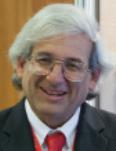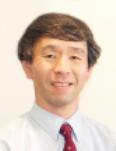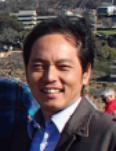Please come to Room 502 everyday at lunch time to enjoy special lunch time lectures by world class scientists.
Lunch boxes are sold in front the room.
Room: 502
|
Michael Freilich Looking Down on the Earth: How Satellites Have Revolutionized Our Understanding of Our Home Planet |
|
scopeEarth is a complex, dynamic system we do not yet fully understand. The Earth system, like the human body, comprises diverse components that interact in complex ways. We need to understand the Earth's atmosphere, lithosphere, hydrosphere, cryosphere, and biosphere as a single connected system. Our planet is changing on all spatial and temporal scales. This presentation will highlight how satellite observations are revolutionizing our understanding of and its response to natural or human-induced changes, and to improve prediction of climate, weather, and natural hazards. |
 |
profileMICHAEL H. FREILICH, Director of the Earth Science Division, Science Mission Directorate at NASA Headquarters. Prior to NASA, he was a Professor and Associate Dean in the College of Oceanic and Atmospheric Sciences at Oregon State University. He received Ph.D. in Oceanography from Scripps Institution of Oceanography (Univ. of CA., San Diego) in 1982. Dr. Freilich's research focuses on the determination, validation, and geophysical analysis of ocean surface wind velocity measured by satellite-borne microwave radar and radiometer instruments. He has developed scatterometer and altimeter wind model functions, as well as innovative validation techniques for accurately quantifying the accuracy of spaceborne environmental measurements. Dr. Freilich has served on many NASA, National Research Council (NRC), and research community advisory and steering groups, including the WOCE Science Steering Committee, the NASA EOS Science Executive Committee, the NRC Ocean Studies Board, and several NASA data system review committees. |
|
|
Takashi Oguchi 地形計測の研究史と地形学の学術出版 |
|
scope地形の計測と、得られたデータに基づく地形の定量的な分析は、地球惑星科学の重要な手法です。本講演の前半では、紙の地形図を用いて手作業で地形を計測していた時代から、DEM(デジタル標高モデル)とGIS(地理情報システム)を活用し、解像度が高く複雑な計測を行う時代に至る研究史を紹介します。また、地形計測の学術的な意義と今後の展望を述べます。本公演の後半では、地形学の国際誌 Geomorphology(Elsevier)のチーフ・エディターを12年間担当してきた経験を踏まえて、学術出版に関する話題を述べます。特に院生やポスドクの方に向けた、国際誌向けの論文の執筆のコツや倫理に関する内容を含みます。 |
 |
profile1963年長野県出身。東京大学理学部と同大学院で地形学を学ぶ。1998年の東京大学空間情報科学研究センターの発足時より同センターに勤務。2009年より教授。2014年よりセンター長。現在エディターもしくはボードメンバーとして6つの国際誌の編集に関与。 |
|
|
Michael Garcia THE HAWAIIAN RIDGE: US-JAPANESE COOPERATION AND NEW PERSPECTIVES |
|
scopeThe Hawaiian Ridge is one of Earths most outstanding geologic features, spanning 3500 km in the north central Pacific basin. The Ridge is classified as a Large Igneous Province with its 70 major volcanoes, which produced 5.5 x 106 km3 of new oceanic crust during the last 50 million years. Along the Ridge there is remarkable variation in the magmatic flux (2-16 m3 s-1), and in volcano shape (conical to giant rift zones >100 km long) and size (<1 to 80 x 103 km3). Numerous giant landslides are found along the Ridge. Rapidly formed oceanic islands like Hawaii pose a serious natural hazard potential for people living in and around the Pacific Ocean. JAMSTEC expeditions to Hawaii (1999-2003) lead to many fundamental discoveries about the Hawaiian Islands. Garcia and colleagues have embarked on a new program of discovery to map and chemically analyze rock samples (including dating) from the poorly known section of the Ridge northwest of the Hawaiian Islands. Highlights of this work will be presented. |
 |
profileMichael Garcia is a Professor of Geology at the University of Hawaii in Honolulu. He joined the University in 1976 as an assistant professor. His classes include igneous petrology, Hawaiian and California geology and how to write a scientific journal paper. Dr. Garcia’s research group focuses on the origin and evolution of Hawaiian volcanoes, including the active and extinct volcanoes from on land and at sea. During the 1999-2000 JAMSTEC expeditions to Hawaii, Dr. Garcia was the lead U.S. representative and dove on the 500th dive of the Shinkai 6500 submersible. Research by Dr. Garcia addresses the generation, differentiation and emplacement of basaltic magmas as well as giant Hawaiian landslides. His research on dike emplacement has taken him twice to the Dry Valleys of Antarctica and to volcanoes around the world (including Japan). His academic training is in geology (B.S., Humboldt State University, California, 1971, Ph.D., University of California at Los Angeles, 1976). In addition to his academic duties, Dr. Garcia is a part-time Technical Judge for the U.S. Nuclear Regulatory Commission. |
|
|
Yusuke Yokoyama 温故知新:"パレオ”が明らかにする表層環境システム |
|
scope複雑な地球表層環境システム。それらの絡まった糸をひとつひとつとき解いていく上で古気候・古海洋学を含むパレオ科学は重要なアプローチです。分析化学手法の発展と計算機資源の発展から、過去の地質・地球化学的手法と地球物理モデルを組み合わせた高精度の復元が可能となってきました。講演では近未来の気候推定の高精度化のための古環境復元の研究について紹介します。 |
 |
profile東京大学大気海洋研究所 准教授。熊本市生まれ。オーストラリア国立大学にてPhDを取得後、同大 地質学科/核物理学科ポスドク研究員。その後渡米しカリフォルニア大学バークリー校宇宙科学研究所研究員、米国エネルギー省ローレンスリバモア国立研究所研究員を経て2002年に東京大学大学院理学系研究科地球惑星科学専攻講師。2008年より現職。 |
|
|
Daniel N. Baker The Impacts of Space Weather on Society and the Economy |
|
scopeModern society depends heavily on a variety of technologies that are vulnerable to the effects of intense geomagnetic storms and solar energetic particle (SEP) events. Strong currents flowing in the ionosphere can disrupt and damage Earth-based electric power grids and contribute to the accelerated corrosion of oil and gas pipelines. Magnetic storm-driven ionospheric disturbances interfere with high-frequency radio communications and navigation signals from Global Positioning System (GPS) satellites. Exposure of spacecraft to solar particles and radiation belt enhancements can cause temporary operational anomalies, damage critical electronics, degrade solar arrays, and blind optical systems such as imagers and star trackers. A complete picture of the socioeconomic impact of severe space weather must include both direct as well as collateral effects of space-weather-driven technology failures on dependent infrastructures and services. |
 |
profileDaniel N. Baker is Director of the Laboratory for Atmospheric and Space Physics, University of Colorado – Boulder and is Professor of Astrophysical and Planetary Sciences and Professor of Physics there. He holds the Moog-Broad Reach Endowed Chair of Space Sciences at CU. He has edited eight books and published over 750 papers in the refereed literature. He is a Fellow of the American Geophysical Union, the International Academy of Astronautics, the American Institute of Aeronautics and Astronautics, and the American Association for the Advancement of Science. He was elected in 2004 as an Associate of the U.S. National Academies and is a member of the U.S. National Academy of Engineering. Dr. Baker was chosen as the 2007 winner of the University of Colorado’s Robert L. Stearns Award for outstanding research, service, and teaching and was the CU Distinguished Research Lecturer in 2010. Dr. Baker was also the 2010 winner of the AIAA James A. Van Allen Space Environments Medal. He was the 2012 recipient of the American Astronomical Society (SPD) Popular Writing Award and Prize and delivered the Van Allen Lecture at the 2012 American Geophysical Union meeting. He currently is lead investigator on several NASA space missions including the MESSENGER mission to Mercury, the Magnetospheric Multiscale (MMS) mission, and the NASA Radiation Belt Storm Probes (RBSP, now renamed the Van Allen Probes) mission. He was a member of the 2006 Decadal Review of the U.S. National Space Weather Program and recently chaired the National Research Council’s 2013-2022 Decadal Survey in Solar and Space Physics. |
|
